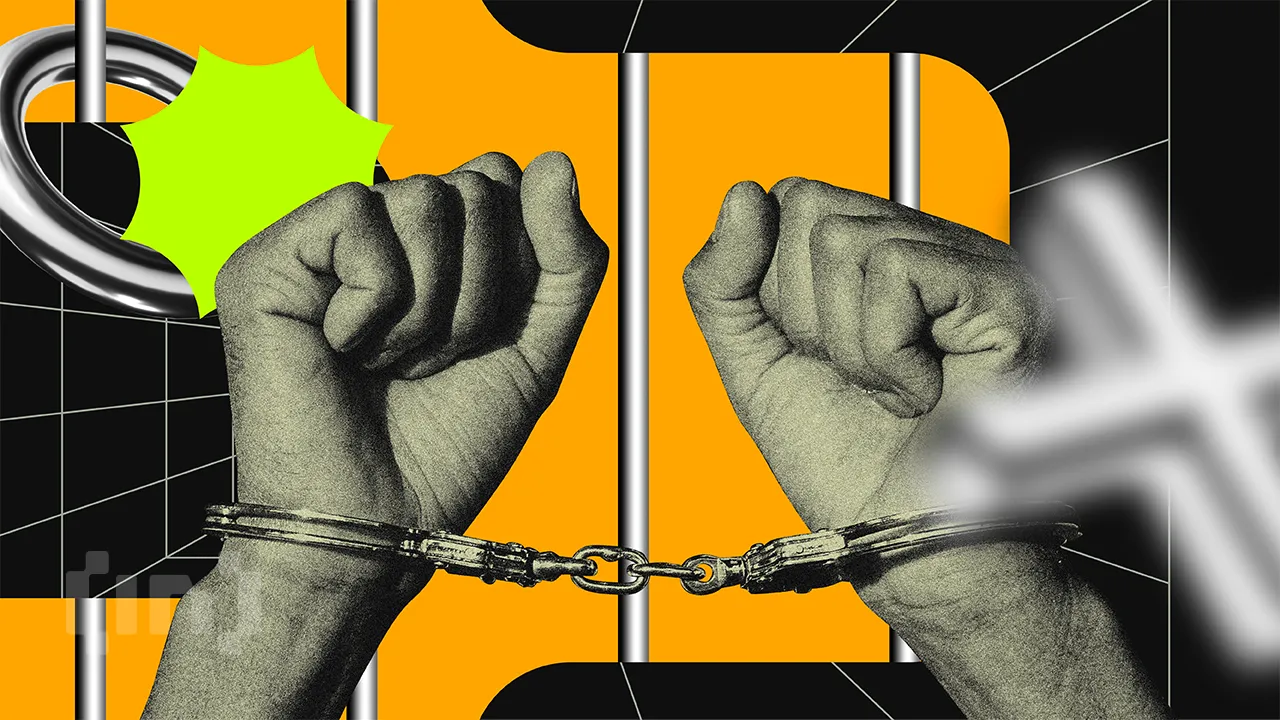Market
Donald Trump’s Crypto App and More

This week brings pivotal events in both the economic and crypto spaces. The US Federal Reserve’s anticipated interest rate decision could shake global markets while Donald Trump prepares to launch his new cryptocurrency platform, World Liberty Financial.
In addition, Solana’s Breakpoint event and MakerDAO’s transformation into Sky are adding excitement to the blockchain space. Several high-profile token unlocks, led by Arbitrum, are also set to increase market volatility. With political, economic, and blockchain developments all converging, this week promises interesting developments for the crypto sector.
How the Fed’s Rate Decision Could Shape Crypto’s Near Future
This week, the Federal Reserve’s interest rate decision is causing major speculation, particularly for risk assets like cryptocurrencies. CME Group data suggests a 59% chance of a 50 basis point (bps) cut and a 41% chance of a smaller 25bps cut. Historically, interest rate changes have significantly affected the crypto markets, particularly for assets like Bitcoin, which were under pressure during September, a month traditionally difficult for crypto.
Analysts at crypto research firm Kaiko point to Bitcoin’s (BTC) “September Effect,” a phenomenon in which the cryptocurrency has declined in seven out of the last twelve Septembers. This trend has continued in 2024, with Bitcoin falling 7.5% in August and another 6.3% so far in September.
Read more: How to Protect Yourself From Inflation Using Cryptocurrency
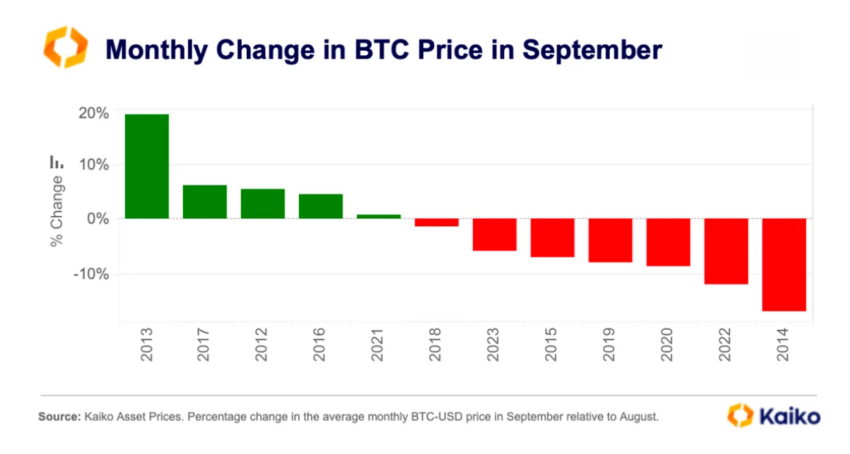
Adding to the mix is a spike in volatility across both Bitcoin and Ethereum. Bitcoin’s 30-day volatility has jumped to 70%, marking almost double last year’s level. Meanwhile, Ethereum’s volatility has also increased, fueled by events like the launch of the Ethereum ETF.
“On a brighter note, the rise in crypto volatility has been accompanied by increased market participation, at least in the Bitcoin market. Bitcoin’s cumulative trade volume for the first eight months of 2024 is up nearly 20% from the previous peak in 2021, approaching a record of $3 trillion,” Kaiko’s analysts noted.
Donald Trump to Launch New Crypto App Ahead of US Presidential Election
Former US President Donald Trump is preparing to launch his new crypto platform, World Liberty Financial, in a live stream from Mar-a-Lago on Monday at 20:00 ET. Trump’s platform aims to position itself as a leading player in the crypto space. It promises to revolutionize finance by offering an alternative to traditional banking systems.
“We’re embracing the future with crypto and leaving the (0:11) slow and outdated big banks behind,” Trump said in a promotional video posted on X (Twitter).
https://x.com/realDonaldTrump/status/1834311432982135015?s=19
The timing of the launch has sparked conversations about the intersection of Trump’s political and business ambitions. However, critics raised concerns about the potential use of government influence to benefit his family’s venture.
Solana Network State, Firedancer, and More: What to Expect at Breakpoint 2024
Solana is set to host its highly anticipated Breakpoint event on September 20-21 in Singapore. Organized by the Solana Foundation, this multi-day event will bring together developers, industry leaders, creators, and blockchain enthusiasts from around the world to explore the latest innovations in the Solana ecosystem. Breakpoint 2024 promises to be the most exciting yet, with discussions on the Solana Network State and Solana 2.0 and keynotes from influential figures like Raj Gokal and Balaji Srinivasan.
Participants can expect workshops, interactive talks, and networking opportunities designed to highlight Solana’s vision for the future of blockchain technology. Attendees will also get exclusive updates on Firedancer, Solana’s next-generation validator client, and other breakthrough developments in the ecosystem.
Sky’s (MakerDAO) Rebranding and New Token Launch
Another key development in the decentralized finance (DeFi) space is MakerDAO’s rebranding to Sky, which will take effect on September 18. Along with the new brand identity comes the launch of two key tokens: USDS, an upgraded version of the DAI stablecoin, and SKY, a governance token that will replace MKR.
Sky’s leadership sees this transformation as necessary to enhance scalability and accessibility within the DeFi ecosystem. The USDS token offers a more resilient, scalable alternative to DAI with the same 1:1 conversion rate. Meanwhile, the SKY token introduces new governance functionalities.
This rebranding is part of Sky’s broader “Endgame Plan,” which aims to address critical challenges in DeFi, including regulatory compliance and scalability. By introducing “Sky Stars,” decentralized projects designed to foster innovation, and Sky.money, a non-custodial platform to simplify access, Sky aims to lead the next phase of DeFi development.
EigenLayer’s Season 2 Stakedrop: What You Need to Know
On September 17, Ethereum’s restaking platform EigenLayer will begin distributing its Season 2 stakedrop. The platform will reward stakers, ecosystem partners, and community members with EIGEN tokens. Approximately 70 million EIGEN tokens, or 4.2% of the total initial supply, will be distributed to participants who actively staked and operated nodes during Season 2. Rewards will be calculated based on each staker’s proportional share of ETH-hours accumulated during the snapshot period on August 15, 2024.
For ecosystem partners, up to 10 million EIGEN tokens, or 0.6% of the supply, will be allocated to contributors who supported EigenLayer through roles in Actively Validated Services (AVSs), Layer-2 rollups, and other decentralized services. Meanwhile, community members, including early advocates, open-source contributors, and supporters since EigenLayer’s inception, will receive around 6 million EIGEN tokens. This amount represents 0.35% of the total supply.
To claim these rewards, community members must verify their social identity through the platform’s portal. This mechanism will ensure that only genuine participants can access their tokens.
ARB and Other Major Token Unlocks This Week
This week, the crypto market will see the unlocking of over $116 million worth of tokens, with Arbitrum leading the charge. Arbitrum’s scheduled token unlock will release over 90 billion ARB tokens, valued at approximately $49.87 million, on September 16. These tokens will be distributed to the project’s team, advisors, and early investors.
Read more: How to Buy Arbitrum (ARB) and Everything You Need to Know
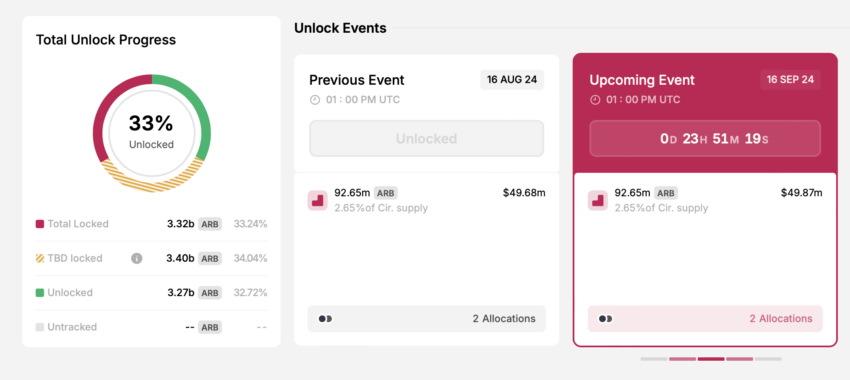
Other notable token unlocks include ApeCoin and Space ID, which are also set to release large quantities of tokens into the market. Token unlocks often increase market volatility as newly available tokens create liquidity but may also prompt sell-offs. Read this article for further detailed information on major crypto token unlocks this week.
Disclaimer
In adherence to the Trust Project guidelines, BeInCrypto is committed to unbiased, transparent reporting. This news article aims to provide accurate, timely information. However, readers are advised to verify facts independently and consult with a professional before making any decisions based on this content. Please note that our Terms and Conditions, Privacy Policy, and Disclaimers have been updated.
Market
Circle Introduces On-Chain Refund Protocol to Strengthen USDC Payments

Circle, the issuer behind the USDC stablecoin, has officially introduced the Refund Protocol—an advanced smart contract framework developed by Circle Research.
This innovation marks a turning point for decentralized stablecoin payments by directly embedding on-chain dispute resolution mechanisms into the blockchain, ensuring digital commerce transparency, security, and trust.
Role of Refund Protocol in the Circle Ecosystem
Traditional stablecoin payment models often lack on-chain refund or dispute resolution mechanisms. Typically, the sender’s stablecoins are held in escrow for a period before being released to the recipient.
An external party, known as an arbiter, oversees this escrow account. However, resolution usually happens off-chain when disputes arise, leading to two major concerns: centralized control by the arbiter and lack of transparency in the dispute process.
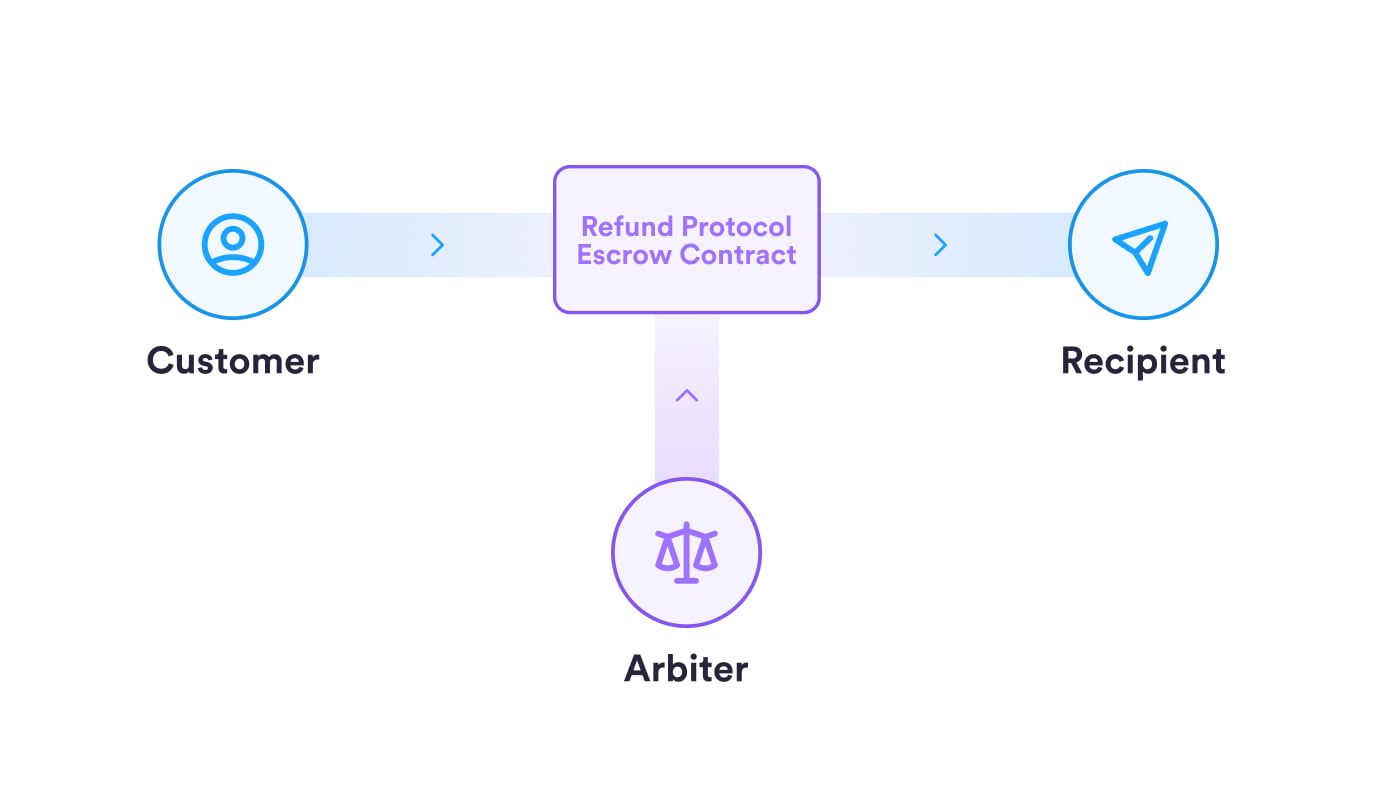
To solve this, Circle has designed the Refund Protocol to enhance the overall stablecoin payment experience, especially for USDC. The protocol acts as a smart contract, enabling non-custodial escrow and on-chain dispute resolution.
“Today, Circle’s R&D team released a new Refund Protocol for stablecoin payments. This builds on our earlier open source releases for confidential payments as well as reversible payments. Progress in mainstreaming stablecoin payments,” said Circle CEO Jeremy Allaire.
Rather than controlling the escrow account, the Refund Protocol can only do two things: release funds to the recipient or refund them to the customer. This removes reliance on third-party intermediaries, increases transparency, and boosts efficiency and user trust.
Refund Protocol to Help USDC Gain Market Share?
According to data from DefiLlama, USDT from Tether currently dominates the stablecoin market with over 61% market share. Although USDC holds the second position, its market capitalization is still less than half that of USDT.

The launch of Refund Protocol provides Circle with a strategic edge. By offering developers and businesses an easy way to integrate USDC payments into e-commerce platforms, NFT marketplaces, and DeFi applications, the protocol strengthens USDC’s position as a flexible and reliable medium of exchange.
Additionally, Refund Protocol gives Circle an advantage by providing a decentralized, low-cost, and transparent solution. This will help USDC stand out in real-world applications.
Refund Protocol may face regulatory hurdles despite its innovation, especially in jurisdictions with strict blockchain laws. The legal recognition of on-chain dispute resolution remains uncertain in many regions, potentially posing one of the biggest obstacles to widespread adoption.
Disclaimer
In adherence to the Trust Project guidelines, BeInCrypto is committed to unbiased, transparent reporting. This news article aims to provide accurate, timely information. However, readers are advised to verify facts independently and consult with a professional before making any decisions based on this content. Please note that our Terms and Conditions, Privacy Policy, and Disclaimers have been updated.
Market
Dogecoin (DOGE) Under Pressure—Bearish Setup Could Trigger Sell-Off

Aayush Jindal, a luminary in the world of financial markets, whose expertise spans over 15 illustrious years in the realms of Forex and cryptocurrency trading. Renowned for his unparalleled proficiency in providing technical analysis, Aayush is a trusted advisor and senior market expert to investors worldwide, guiding them through the intricate landscapes of modern finance with his keen insights and astute chart analysis.
From a young age, Aayush exhibited a natural aptitude for deciphering complex systems and unraveling patterns. Fueled by an insatiable curiosity for understanding market dynamics, he embarked on a journey that would lead him to become one of the foremost authorities in the fields of Forex and crypto trading. With a meticulous eye for detail and an unwavering commitment to excellence, Aayush honed his craft over the years, mastering the art of technical analysis and chart interpretation.
As a software engineer, Aayush harnesses the power of technology to optimize trading strategies and develop innovative solutions for navigating the volatile waters of financial markets. His background in software engineering has equipped him with a unique skill set, enabling him to leverage cutting-edge tools and algorithms to gain a competitive edge in an ever-evolving landscape.
In addition to his roles in finance and technology, Aayush serves as the director of a prestigious IT company, where he spearheads initiatives aimed at driving digital innovation and transformation. Under his visionary leadership, the company has flourished, cementing its position as a leader in the tech industry and paving the way for groundbreaking advancements in software development and IT solutions.
Despite his demanding professional commitments, Aayush is a firm believer in the importance of work-life balance. An avid traveler and adventurer, he finds solace in exploring new destinations, immersing himself in different cultures, and forging lasting memories along the way. Whether he’s trekking through the Himalayas, diving in the azure waters of the Maldives, or experiencing the vibrant energy of bustling metropolises, Aayush embraces every opportunity to broaden his horizons and create unforgettable experiences.
Aayush’s journey to success is marked by a relentless pursuit of excellence and a steadfast commitment to continuous learning and growth. His academic achievements are a testament to his dedication and passion for excellence, having completed his software engineering with honors and excelling in every department.
At his core, Aayush is driven by a profound passion for analyzing markets and uncovering profitable opportunities amidst volatility. Whether he’s poring over price charts, identifying key support and resistance levels, or providing insightful analysis to his clients and followers, Aayush’s unwavering dedication to his craft sets him apart as a true industry leader and a beacon of inspiration to aspiring traders around the globe.
In a world where uncertainty reigns supreme, Aayush Jindal stands as a guiding light, illuminating the path to financial success with his unparalleled expertise, unwavering integrity, and boundless enthusiasm for the markets.
Market
Is XRP’s Low Price Part of Ripple’s Long-Term Growth Strategy?

Ripple’s recently acquired Hidden Road has secured a broker-dealer license from the Financial Industry Regulatory Authority (FINRA). This marks a significant milestone in expanding its prime brokerage services for institutional investors.
Market watchers see it as a deliberate strategy by Ripple to build infrastructure and position itself for future growth. That being said, traders are expecting that XRP’s value will rise later.
Ripple Expands Institutional Presence with Hidden Road’s FINRA License
According to the latest press release, Hidden Road Partners CIV US LLC was granted approval. The license now enables the firm to provide a broader suite of regulatory-compliant services, including clearing, financing, and prime brokerage for fixed-income assets to institutions.
Noel Kimmel, President of Hidden Road, highlighted that the license was a pivotal development for the company. According to him, it enhances Hidden Road’s ability to operate in traditional financial (TradFi) markets.
“As a FINRA member, we will be able to bring our best-in-class, technology-driven fixed income service offering to an expanded universe of institutional clients. Our business has tremendous momentum, and we look forward to continuing to provide superior execution and support to our clients amidst today’s exceptionally dynamic market environment,” Kimmel said.
The FINRA approval follows Ripple’s $1.25 billion acquisition of Hidden Road. Announced on April 8, 2025, this was one of the largest deals in the digital assets sector.
The move positions Ripple as the first cryptocurrency company to own a global, multi-asset prime broker. Experts believe the acquisition and subsequent license are part of a broader strategy Ripple is employing.
“Hidden Road just secured a broker-dealer license right after Ripple’s acquisition. This isn’t a coincidence, it’s a statement. XRP is not playing checkers. It’s playing regulatory chess,” an analyst wrote on X (formerly Twitter).
Is Ripple Behind XRP’s Low Price? Analyst Thinks So
In fact, analysts also claim that XRP’s neutral reaction to recent milestones isn’t a sign of weakness but rather a strategic move. In a recent analysis, crypto analyst Levi argued that the current price of XRP, hovering around $2, is not coincidental, but rather a result of Ripple’s deliberate approach.
He suggested that the low price is designed to allow Ripple to operate under the radar while making key strategic moves, such as the Hidden Road acquisition.
“Hidden Road isn’t a flex. It’s infrastructure. It’s the final puzzle piece — giving Ripple a fully integrated, lightning-fast, global value settlement system,” he stated.
The analyst emphasized that while the public focused on Ripple’s legal battles with the SEC, the company quietly built its global value settlement system behind the scenes.
“XRP at $2 isn’t undervalued — it’s deliberately suppressed. When the switch flips, the revaluation won’t be gradual — it’ll be instant,” Levi noted.
In his view, those who have invested early will be positioned to benefit as the market shifts. Meanwhile, XRP, after hitting an all-time high earlier this year, has continued to decline.

At press time, the altcoin was trading at $2.0. According to BeInCrypto data, this represented a decline of 1.0% over the past day.
Disclaimer
In adherence to the Trust Project guidelines, BeInCrypto is committed to unbiased, transparent reporting. This news article aims to provide accurate, timely information. However, readers are advised to verify facts independently and consult with a professional before making any decisions based on this content. Please note that our Terms and Conditions, Privacy Policy, and Disclaimers have been updated.
-

 Altcoin23 hours ago
Altcoin23 hours agoHow Rising Solana Network Inflows Could Drive SOL Price to $150?
-

 Bitcoin22 hours ago
Bitcoin22 hours agoGary Gensler Explains Why Bitcoin Will Outlast Altcoins
-
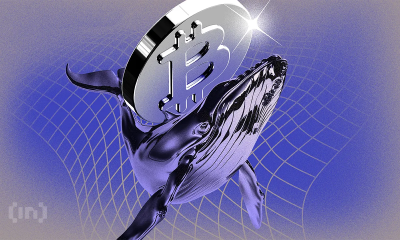
 Market22 hours ago
Market22 hours agoBitcoin Whales Withdraw $280 Million: Bullish Signal?
-

 Altcoin15 hours ago
Altcoin15 hours agoCZ Honors Nearly $1 Billion Token Burn Promise
-

 Market18 hours ago
Market18 hours agoBitcoin Price Poised for $90,000 Surge
-

 Market23 hours ago
Market23 hours agoXRP’s $2.00 Pivot Point—A Launchpad or Breakdown Zone?
-

 Market15 hours ago
Market15 hours agoOver $700 Million In XRP Moved In April, What Are Crypto Whales Up To?
-

 Altcoin22 hours ago
Altcoin22 hours agoHow Crypto Traders Made $666K from $4.5K in One Trade?





